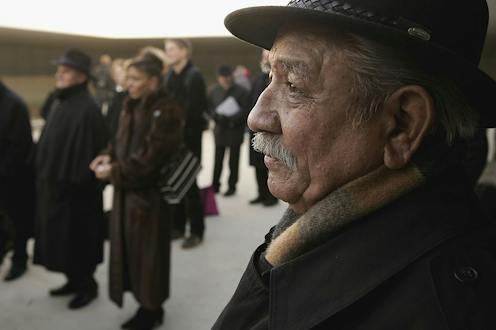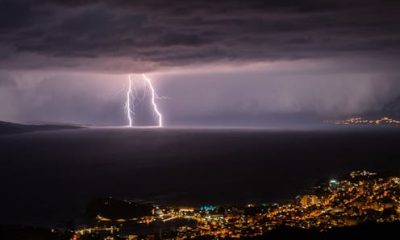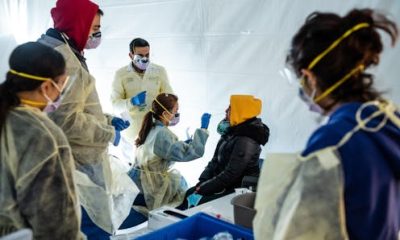
Franz Roselbach, a Roma survivor of the Holocaust who was sent to Auschwitz when he was 15, attends a ceremony at the former Sachsenhausen concentration camp in 2006. Sean Gallup/Getty Images
When the United Nations passed a resolution to designate Jan. 27 International Holocaust Remembrance Day, it did not define the Holocaust. The 2005 proclamation merely noted that it “resulted in the murder of one third of the Jewish people, along with countless members of other minorities.”
Among those unnamed other minorities are Roma, who deserve to be part of the larger story of the Holocaust commemorated on this day. Their story is closely connected with that of Jews’ suffering and struggle for recognition – a relationship at the center of my 2023 book, “Rain of Ash.”
A Romani flag waves during an event on International Romani Day in front of Berlin’s Brandenburg Gate.
Adam Berry/Getty Images
A chilling report
To understand the connections between Jewish and Romani experiences, it is useful to return to one of the key moments when Europe’s Jews began to realize that they faced a new type of threat: systematic mass murder.
In March 1942, a prisoner fled Chelmno, a Nazi extermination camp in present-day Poland, and escaped to the Warsaw Ghetto. There, he told members of the ghetto’s underground resistance movement about mass killings in gas vans.
Szlamek, as the witness was known, recounted how Jewish prisoners had been forced to dig mass graves for truckload upon truckload of murdered Roma from Austria. In his vivid description of the process, he reported how these Jewish gravediggers warmed themselves by putting on the clothes of the Romani victims. Once their work for the day was done, the SS forced these Jews to lie on the bodies of those already in the burial pits before being shot themselves.
It’s a haunting image: Jews murdered on top of the Roma whose clothes they were wearing. It also encapsulates how connected the murders of these two groups were, even as the crimes committed against them continue to be remembered as distinct events.
Missing chapter
Younger generations in the United States are not able to identify basic facts about the Jewish Holocaust, according to surveys by the Claims Conference, which advocates for restitution for Jewish victims and their descendants. Around half of millennial and Gen Z respondents could not name a single ghetto or concentration camp, and just over a third knew how many Jews had been murdered: around 6 million.
The public knows even less about the Romani Holocaust. Indeed, the history of Europe’s largest ethnic minority is a blank slate for many Americans, even those who consider themselves well-informed.
Dr. Robert Ritter, whose pseudo-scientific work contributed to the Nazis’ forced sterilization and murder of Romani people, interviews a woman in 1938.
Galerie Bilderwelt/Getty Images
This is not a matter of students ignoring, or not properly absorbing, the lessons available in their history textbooks, as is the case for the Jewish Holocaust. Romani history is rarely in the textbooks to begin with.
Romani activists are keenly aware of this, and frequently they see Jews’ relative success telling the story of their genocide as a model for Romani struggles for recognition.
Nazi Germany persecuted many groups; concentration camps were originally built to imprison the regime’s political opponents, while the first dedicated killing sites’ purpose was to murder disabled people. Among those persecuted, Roma and Jews were the only groups whom the Nazis and their allies systematically persecuted in large numbers as entire families – whether by deporting them to concentration and death camps, or systematically shooting them as racialized groups in occupied areas of the Soviet Union.
As with Jews, many of Roma’s experiences of persecution and genocide occurred in locations well known to people who have learned something about the Holocaust, such as Auschwitz or the Lodz ghetto in occupied Poland. The Roma murdered in Chelmno came from Lodz, where the Nazis had deported over 5,000 Roma from Austria in November 1941. Many Austrian Roma who avoided these early deportations eventually ended up in Auschwitz.
Gestapo dossiers for Roma people, whom the Nazis persecuted and considered ‘foreign and inferior.’
Horacio Villalobos/Corbis via Getty Images
In the end, the Nazis killed approximately three-quarters of Austria’s prewar Romani population: approximately 9,000 men, women and children. Among countries where the Romani genocide took place, this was one of the highest rates of murder, next to Latvia, Estonia and the areas of today’s Czech Republic that the Nazis called the Protectorate.
In many other locations, totals are less clear. Serious estimates for the overall number of victims range widely, from 120,000 to over half a million.
Many languages, many faiths, many countries
Romani people are highly diverse. They have many religions: Catholicism, Protestantism and Orthodox Christianity as well as Islam. Many speak Romani as their first language, while others don’t. Whatever their relationship to the Romani language, all Roma are at home in at least one other language, depending on what country they live in.
Historically, many Romani families in Western Europe lived as itinerant traders and craftspeople, contributing to the popular image of them as travelers with wagon homes. Most Roma in Europe, however – particularly in Southeastern and East Central Europe, where the largest Romani populations live – have been settled for many generations. Whether considered nomadic or settled, they were stigmatized: frequently isolated at the edge of settlements, excluded from civil rights, and targeted as a dangerous “nuisance” by authorities.
When the Nazis and their allies persecuted this diverse population as “Gypsies,” they were able to rely on policies to police and surveil them that had been in place since the late 19th century.
These policies, including special identity cards with fingerprints, did not disappear after liberation. Instead, following the Second World War, Roma across Europe remained marginalized and overpoliced in ways that made it hard for them to gain recognition of the genocide they had experienced.
Shared stories
An international Romani civil rights movement that took shape in the 1970s, building on earlier local efforts to organize, slowly changed this. Organizations like the International Romani Union, the European Roma Institute for Arts and Culture and the Central Council of German Sinti and Roma, are forming a new landscape for Romani politics and recognition.
From the start, their efforts were tied together with those of Jewish victims. Jewish survivors could build on a much longer history of international organizing and philanthropy, and after 1945 they could rely on the help of the thriving U.S. Jewish community in their quest to document Nazi crimes and explain them to the wider public. Many of the oldest Jewish institutions in this field, such as the Wiener Holocaust Library in London, offered crucial support, as scholars and activists strove to tell the history of the Romani Holocaust.
Hermann Hoellenreiner, a Sinto Holocaust survivor, shows his prisoner tattoo to David Lewin, a Jewish Holocaust survivor, as they and officials travel to a commemoration ceremony in 2011.
Jesco Denzel/AFP via Getty Images
Roma and Jews found new ways to connect through their efforts for recognition and redress, though Jewish intellectuals, activists and institutions had much greater access to resources. The Shoah Foundation’s Visual History Archive is emblematic here: It has over 50,000 video interviews with Jewish survivors and 406 with Romani survivors. Yet this is nevertheless the largest dedicated collection of Romani testimony in the world.
While this unequal partnership has not dissolved, it is transforming. Jewish institutions are increasingly investing resources to preserve and digitize Romani history and to promote public education about both peoples’ experiences in collaboration with Romani activists. At the same time, Romani and Jewish activists are working together to overcome antisemitism and anti-Roma sentiment – linked by a sense that understanding history is essential for the defense of liberal democracy.
Ari Joskowicz received funding from the American Philosophical Society, the United States Holocaust Memorial Museum, the Oxford Centre for Hebrew and Jewish Studies, the American Society of Learned Societies, and the Vienna Wiesenthal Institute for Holocaust Studies.
Advertisement

Advertisement
Contact Us
If you would like to place dofollow backlinks in our website or paid content reach out to info@qhubonews.com











